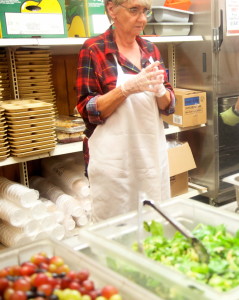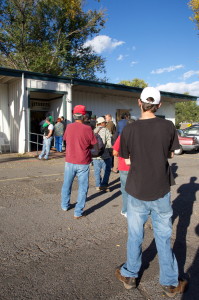
Clients of the Flagstaff Family Food Center: Food Bank and Kitchen, patiently wait in line for a hot meal at the center on Second Street. While volunteers and food donations typically increase during the holiday season, organizers say it’s just as important for the community to provide support for the center throughout the entire year. Photos by Star Hunter / AmigosNAZ ©2014
While donations, volunteers are welcomed during the holidays, officials say need must be met throughout the entire year
By Frank X. Moraga / AmigosNAZ
Right after Halloween thoughts start turning toward Thanksgiving, Christmas and other holidays. You can’t escape it on TV with the ever-growing number of Christmas shopping commercials dominating the airways, many of which started appearing well before the end of the trick-or-trick season.
But besides crass commercialism, the holiday season for many is also a time to start thinking about those in need in the community, those who haven’t benefited from the nation’s slow economic recovery, those who still need a warm place to sleep and food on the table for themselves and their families.
Yes, ’tis the season of giving and the public will continually be reminded of that with every Salvation Army red bucket situated in front of retail stores, every U.S. Marine Corps’ Toys for Tots collection box located in libraries, community centers and other locations, and of course, the ubiquitous turkey drive.
Would-be volunteers will be flooding local food banks, with many food banks receiving the lion’s share of food and cash donations during the holiday season.
But what about the rest of the year when volunteers and donations trickle in while the need continues through a frosty spring, a warm summer’s day and a pleasant autumn evening?
That is the dilemma facing many organizations across the nation like the Flagstaff Family Food Center: Food Bank and Kitchen.
Nearly 75 percent of the organization’s monetary donations come during October, November and December, along with a growing number of inquiries about volunteering during the holiday season, said Steve Saville, executive director.
“Everyone wants to volunteer for Christmas and Thanksgiving. No one wants to come in February,” he said.
Donations of traditional holiday food fare also dominate this time of year.
“I don’t know what it is about turkey that makes people go nuts,” he said.
While the donations of volunteers and turkey are appreciated, it is up to Saville and the rest of the board at the center to figure out how to spread the monetary donations received during the holidays to meet the needs of the community year round.
While the nation is sluggishly recovering from the impact of the Great Recession, Saville said the need to help local families has in fact grown in recent years.
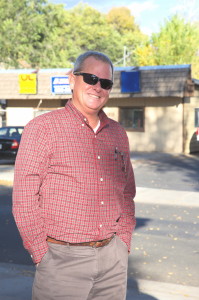
Steve Saville, executive director of the Flagstaff Family Food Center, said he is proud of the work accomplished by the food bank but keenly aware of the challenges that lay ahead.
Adding to the problem was the closure of St. Mary’s Food Bank’s warehouse in Flagstaff in late October 2013 as it centralized operations in Phoenix.
The pending closure of St. Mary’s warehouse contributed to the merger of the Flagstaff Family Food Center and the Northern Arizona Food Bank, a merger that resulted in the creation of the Flagstaff Family Food Center: Food Bank and Kitchen.
Prior to the merger on Oct. 1, 2013, the Flagstaff Family Food Center — which was founded on Dec. 25, 1991— was serving a hot meal to about 7,000 clients per month. Within 20 days, the center was feeding nearly 15,000 people through a range of eight programs, including providing more than 1,380 emergency food boxes.
By the end of 2013, the center had fed about 81,000 people, with that number is expected to more than triple by the end of this year, Saville said in an Arizona Daily Sun article, which also reported on the center’s $200,000 shortfall from its projected $880,000 annual budget that required the layoff of four full-time workers.
The growing food need from the community, capital expenses such as refurbishing walk-in freezers and installing a drive-through food distribution access, coupled with lower-than-expected funds raised during the first half of 2014, led to the decision to cut back on overhead in order to maintain food distribution services to the community.
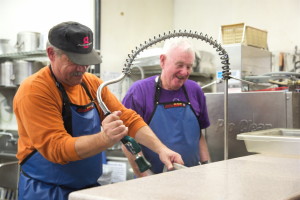
Curt Knight and David Downes are busy in the kitchen prior the opening of that evening’s hot meal session.
“We didn’t want to do it,” Saville said of the layoffs. “But (the budget cut) put us at great risk.”
Besides canned food and cash donations from individuals, the nonprofit center — which receives no government funding — receives donations from local businesses and such organizations as the United Way of Northern Arizona, the Flagstaff Community Foundation, Forest Highlands Foundation and the City of Flagstaff, among others.
Bulk food donations are collected and stored at the center’s warehouse at 3805 E. Huntington Drive, Flagstaff.
Donated food is prepared and distributed at the center’s location at 1903 N. Second St. in the Sunnyside neighborhood of Flagstaff.
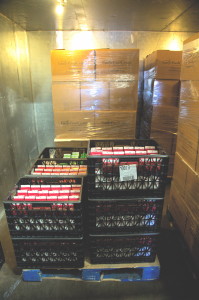
Large refurbished refrigeration units are put to work storing perishables for the drive-by food distribution Kitchen Door Lunch and other programs.
All rescued food, including donated produce, is sorted, cleaned, cooked or given to clients almost immediately, along with donated bread, milk and other dairy products.
“We have 48 hours to get it distributed,” Saville said.
During a tour of the center, Saville showed how composted food items are collected and given to local ranchers, who in turn donate eggs and other dairy products to the center.
The center also distributes some of the food boxes from St. Mary’s Food Bank Alliance, which brings up 18-wheelers every month to distribute 12 million pounds of food throughout northern Arizona each year.
One of the challenges in the past with feeding those in need has been lack of access to the program due to lack of personal transportation or other issues.
The center takes the food out to those in need through its eight programs including:
- The free Hot Meal Program held from 4 to 5:30 p.m. daily at the Sunnyside location. The service has been available for more than 20 years.
- The Emergency Food Box program, open from 9 a.m. to 1 p.m. Tuesday through Friday, which distributes more than 30,000 food boxes to the community.
- Free grocery shopping for more than 50 local nonprofit agencies, which can visit and shop at its warehouse, open from 1 to 4 p.m. Monday through Friday.
- The Flagstaff Kitchen Mobile Lunch Program where pre-made lunches are distributed each month to local nonprofit agencies.
- The Kitchen Door Lunch Program, where to-go sack lunches are distributed each month.
- The Breakfast Burrito Program delivered to the local homeless shelter each month.
- The Backpack Program that distributes food to high-risk elementary school students to make sure they can receive daily nourishment to fully concentrate on their studies.
- The Children’s Literacy Program, with volunteer tutors and the donation of more than 4,500 books to children in 2013.
Most of the food services are provided to working poor families in the region, Saville said.
“We have a very small homeless population in Flagstaff,” he said.
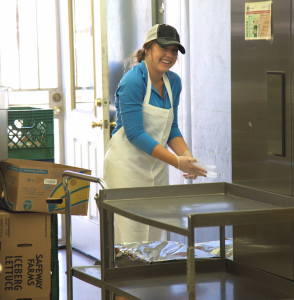
Brooke Potts, a student from Northern Arizona University, cheerfully works at the Flagstaff Family Food Center as part of her 25-hours of community service requirements.
As budgets get stretched during the month, Saville said “by the end of the month hot meal (service) goes up. If you can feed your family two or three nights a week, that’s a lot of money you can save.”
The need to feed families in Northern Arizona and the state continues.
In the most recent “Meal Gap” survey released in April 2014 by Feeding America, a total of 18.5 percent, or 24,770 of Coconino County’s population, was “food insecure” in 2012, up from 18.3 percent reported in the 2011 survey. A total of 70 percent of those individuals were falling below the 185 percent Supplemental Nutritional Assistance Program (SNAP) federal poverty level.
More information can be found at http://www.feedingamerica.org/hunger-in-america/our-research/map-the-meal-gap/
As in 2011, Coconino was ranked fifth highest in the state during 2012, trailing only Apache (25.7 percent), Yuma (24.3 percent), Navajo (22.4 percent) and Santa Cruz (18.8 percent) counties.
Statewide, one in five Arizonans continued to live in poverty in 2012, unchanged from the prior year, increasing to one in four children and one in seven seniors. Arizona’s hunger rates continue to be higher than national averages with 17.8 percent of Arizonans food insecure, compared to 15.9 percent nationally, according to information provided by St. Mary’s Food Bank Alliance. A total of 28.2 percent of Arizonan children face hunger, compared to 21.6 percent nationally.
Donation options:
Donations to the Flagstaff Family Food Center: Food Bank and Kitchen can be made by:
Going to http://www.hotfood.org/subjects/donations/donations.htm
Sending a check to: Flagstaff Family Food Center, P.O. Box P, Flagstaff, AZ 86002.
The Flagstaff Family Food Center: Food Bank and Kitchen also benefits from the State of Arizona’s Working Poor Tax Credit that is available to organizations and individuals who provide help to the working poor. A $200 donation by an individual or a $400 donation by a couple to the center reduces the amount of state taxes by the same amount. Visit http://www.hotfood.org/index.htm or https://www.youtube.com/watch?v=Caaoq0COaRs&feature=youtu.be for more information about the tax credit.
For more information, call the Flagstaff Family Food Center: Food Bank and Kitchen at 928-774-3188 or send an email to info@hotfood.org.

